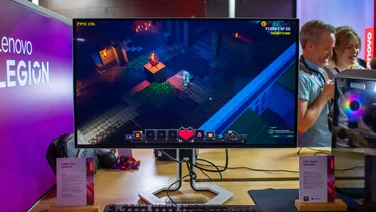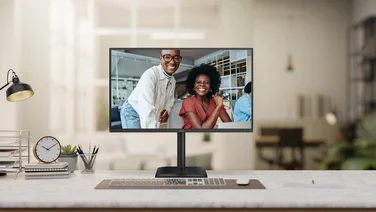To help us provide you with free impartial advice, we may earn a commission if you buy through links on our site. Learn more











- Smart, practical design
- Brilliant image quality in SDR and HDR
- Screens can be used independent of one another
- Screen coating is annoyingly reflective
- The automatic pivot is buggy
- Overkill for most users
If you’re shopping for a simple, affordable portable monitor, then look away now – the £565 Asus ZenScreen Duo MQ149CD may tempt you to blow your budget. Its dual 14in OLED screens are housed in a gorgeous, uber-flexible body, and the image quality is good enough to make 99% of laptop screens look frighteningly average. Given a big enough budget, this is the ultimate pick of the portable monitor crop.
A quick glance at the specifications swiftly justifies the price. Asus proudly touts a claimed 100% DCI-P3 coverage, a peak HDR brightness of over 500cd/m2 and a guaranteed Delta E colour accuracy of less than 2 for both displays.
Factor in the practical design which allows you to power both displays with a single USB-C cable, or simply share them between two devices, and Asus has served up a recipe for portable OLED nirvana.
Asus ZenScreen Duo OLED MQ149CD: What do you get for the money?
The MQ149CD is a devilishly handsome little device. The dark brushed aluminium finish looks lovely, and Asus has managed to squeeze the twin 1,920 x 1,200 OLED screens into an impressively svelte clamshell design. With the screens folded shut, the whole thing measures 320mm wide, 210mm deep and a mere 15mm thick. That’s around the size of a fancy 14in ultraportable laptop, but it actually weighs a little less than most at 1.07kg.
You also get a 30W wall-wart USB-C charger in the box, some nice-feeling braided cables and a tough-feeling slipcase to keep everything together and in one piece. The pair of right-angled USB-C cables are useful, and there’s an HDMI to mini-HDMI cable, too, which is handy for any devices that aren’t fitted out with USB-C. A pocket on the slipcase’s front panel provides just enough room for all three cables with a bit of a squeeze.











Open up the Zenscreen Duo and the design is really neat. A fold-out kickstand at the rear allows you to position the two displays in landscape or portrait modes, and the 360-degree hinge means you can fold them backwards into “tent” mode. You can use this mode to present to someone across the table, or even allow them to independently connect to and use the second display, which is rather ingenious.
The basic kickstand does limit adjustability a tad, but Asus has you covered. There’s a small tripod adapter in the box and this screws into the rear of the MQ149CD to provide a standard tripod-style 1/4in thread. Grab your camera tripod and you’ll be able to use it as a makeshift adjustable stand.
If, however, you prefer something tailor-made, then you can buy the Asus MTS02D for around £60, which gives you a portable stand with 180-degree pivot, 215mm of height adjustment and ample amounts of tilt.











The sheer number of display and usage configurations makes it easy to get the most from the MQ149CD. You can use any combination of the two USB-C inputs and mini-HDMI input for multi-monitor and multi-device setups. For instance, I connected a single USB-C cable from a Dell Pro 14 Premium laptop and was able to use the displays as one larger display – or two separate displays – just by toggling settings in the onscreen display (OSD) menus.
You can also use the displays independently of one another; simply connect two devices and toggle your preferred pairing in the OSD. The sensible menu structure and small jog-wheel control make it supremely easy to adjust the setup to your liking. You can also tweak the various settings in the Asus display Widget Center app.
The first minor niggle is that the screen doesn’t consistently automatically pivot when you rotate it from landscape to portrait and vice versa. You’ll need to install Asus’ Display Widget Center software to get it working, but in my testing it only functioned for switching between standard and tent modes. Turn the MQ149CD around into portrait mode and only the left panel rotates automatically.











The result? I had to manually rotate my head 90 degrees to try and navigate Windows 11’s Settings menu to get everything to line up. Thankfully, Asus has been more considerate elsewhere: little rubber feet are dotted along the MQ149CD’s short and long edges to prevent it sliding around in either orientation.
If you’re wondering why Asus bothered supplying a 30W wall-wart charger in the box, then it’s because the MQ149CD can potentially draw more power than a laptop’s USB-C connection can supply.
A single cable will suffice if you keep the display brightness below around 50%, both in both HDR and SDR modes. But beware, if you bump up the brightness too high, the MQ149CD will go into a reboot loop.
It’s not meant to do this – the manual explicitly says it should detect the input power and adjust the brightness to suit – but I suspect a firmware update is needed to fix the issue. Once it gets into this loop, the only way to fix it is to connect a USB-C power supply and dial the brightness back down again.
How good is the image quality?
In a word, stunning. Just turn on the MQ149CD and you’re immediately greeted by bright, clean white, deep black and intensely saturated yet natural colours. In my testing, it delivered 99% DCI-P3 coverage, 97.5% of Adobe RGB and 100% of sRGB. In SDR mode, peak brightness was 372cd/m2, and HDR mode bumped that up to 578cd/m2. As you’d expect for an OLED display, contrast is infinite.
Colour accuracy is incredible for a portable display. In Standard mode and tested against a Display P3 target, the MQ149CD achieved an average Delta E of 0.87 and a maximum of 1.81. The 6,115k white point is a tad too warm, but gamma is a perfect 2.2.
The sRGB mode is similarly refined. The average Delta E is 0.74 with a maximum of 1.69. The white point was too warm at 6,098k, but gamma again measured at a perfect 2.2.











The low white point in both modes does perhaps add a little extra warmth, but it’s not something to worry about. If you do need perfection, then you’ll just need to reach for a colorimeter and perform a software calibration – it’s not possible to adjust the white point in the on-screen display when using the preset sRGB or DCI-P3 modes.
The result of these figures is that the MQ149CD is a joy to behold. In SDR mode, the combination of colour accuracy, perfect black levels and ample brightness make for a delightful combination. In HDR mode, all of those traits are amplified yet again.











Despite the modest-sounding DisplayHDR 400 True Black certification, the MQ149CD’s 578cd/m2 peak brightness is just high enough to allow HDR content to produce modestly bright highlights, deep shadows and richly textured hues. Similar certifications on LCD panels are a recipe for extreme disappointment, but that isn’t the case here – this monitor is in a completely different class.
If you’re already daydreaming about gaming or watching movies with near perfect colour accuracy, then you’ll be doubly glad to hear that the panels’ response times are similarly good. The 60Hz refresh rate puts a limit on your frame rate for gaming, but while it lacks the silky smooth, perfect motion handling of high refresh rate displays, I couldn’t detect any blur or ghosting in the SmoothFrog response time tests.
If there’s one criticism to be levelled at the ZenScreen MQ149CD, it’s that the glossy anti-glare coatings are incredibly reflective. The result is you’ll spend a fair bit of time admiring your own face and surroundings. It does take the edge off strong light sources – there’s no glare at all, even with a torch pointed directly at the panel – but if you have a dislike of glossy displays then this might not be the screen for you.
Should I buy the Asus ZenScreen Duo OLED MQ149CD?
Admittedly, Asus has made some minor missteps – the finicky auto pivot and iffy power sensing are mildly irksome – but they’re nowhere near egregious enough to sour the MQ149CD’s appeal. And I’m hopeful that both of those issues will be swiftly remedied with a firmware update.
It’s very expensive by portable monitor standards, but – if you can afford it – the Asus Zenscreen Duo MQ149CD is worth every penny. The combination of superb image quality and thoughtful design are second to none. While most portable monitors satisfy their design goals with being just good enough, the ZenScreen Duo MQ149CD only stops short of absolute perfection. It’s the very definition of an Expert Reviews Best Buy.











Asus ZenScreen Duo specifications
| Display | Dual 14in OLED panel |
| Panel resolution | 1,920 x 1,200 |
| Refresh rate | 60Hz |
| Panel response time | 1ms GtG |
| Adaptive Sync Support | No |
| HDR Support | Yes, DisplayHDR 400 True Black |
| Ports | USB-C power input, 2 x USB-C (DP Alt Mode), 1 x mini HDMI |
| Other features | Microfibre cloth, mini HDMI to HDMI cable, MTS02D tripod socket kit, power adapter, quick start guide, 2 x USB-C cable, warranty card, ZenScreen bag |
| Stand | Kick-stand, non-adjustable |
| Dimensions (with stand) | 319 x 212 x 15mm (WDH), folded |
| Weight (with stand) | 1.07kg |







